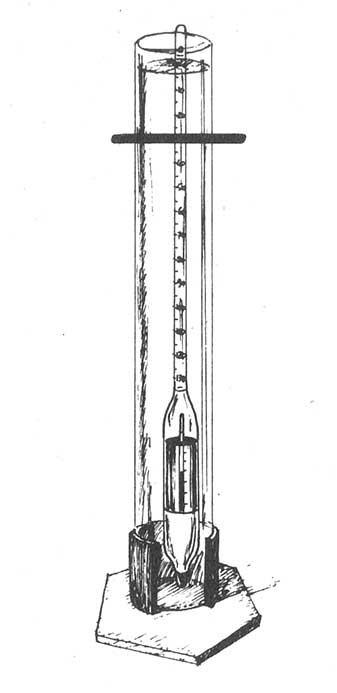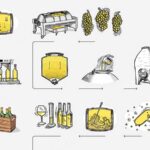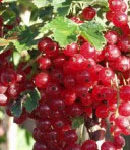Określanie ciężaru moszczu.
Można by tu mówić także o określaniu zawartości cukru w soku, ale sformułowanie „ciężar moszczu” wskazuje na metodę pomiaru; moszcz rzeczywiście się waży.
Zanim bliżej zajmę się analizą, którą można wykonać we własnym zakresie, na początek kilka podstawowych uwag. Stojący przed nami w przezroczystym naczyniu sok składa się – w zależności od rodzaju owoców, z których powstał – w 80 – 90, a nawet 95% z wody.
Resztę stanowi cukier, ekstrakt bezcukrowy, garbniki, pektyna, białko, składniki aromatyczne, mineralne i barwniki. Ich skład zmienia się w zależności od rocznika, miejsca uprawy, klimatu, stopnia dojrzałości owoców i sposobu ich przetwarzania. Do najważniejszych składników ekstraktu ogólnego należą obok cukru kwasy, których ilość zmienia się w zależności od rodzaju owoców. Zawartość cukru w winogronach wynosi średnio niespełna 20%, a kwasów przeciętnie 1%, jabłka zawierają także około 1% kwasów, ale zawarty w nich cukier osiąga przeciętnie 7%. Najbogatszym w kwasy owocem jest borówka brusznica, która zawiera ich więcej niż 2%, przy czym jest w niej zaledwie 1,5% cukru. Natomiast w gruszkach jest tylko 0,3% kwasów, a ponad 8% cukru.
Są to Wartości, które trzeba brać pod uwagę przy wyrobie wina, ale tylko jeden składnik soku, występujący w najmniejszych ilościach, tak zwany ekstrakt bezcukrowy, tworzy to, co później w gotowym już winie określamy jako „bukiet”. Nie da się go zanalizować w warunkach domowych, można go jednak określić za pomocą smaku i węchu.
Podczas analizy soku obok zawartości wody najbardziej będzie nas interesowała zawartość cukru, ponieważ w procesie fermentacji odgrywa on główną rolę. Chociaż w soku owocowym znajdują się różne rodzaje cukrów, należy jednak obliczać ogólną wartość cukru, którą mierzy się w opisany niżej sposób.
Używa się w tym celu przyrządu pomiarowego, który w ubiegłym stuleciu wynalazł aptekarz Ochsle. Jest on łatwy w obsłudze, nietrudno odczytywać z niego wyniki pomiarów, a działa według następującej zasady.
Ciężar jednego litra wody, 1000 gramów, uznaje się za wartość stałą. Ważąc sok z winogron, pan Ochsle stwierdził, że jego ciężar zwiększał się w zależności od rocznika, stopnia dojrzałości owoców, miejsca uprawy oraz klimatu i wynosił przeciętnie 1060-1080 gramów. Stąd Ochsle wysnuł wniosek, że nadwyżka wagi, a więc 60-80 gram na litr, musi być ciężarem ekstraktu (głównie cukru). Skonstruowana przez niego waga do ważenia moszczu wskazuje właśnie tę nadwyżkę wagi.

Przyrząd pomiarowy to szklany pojemnik obciążony ołowiem lub rtęcią i zakończony u góry cylindryczną szklaną rurką ze skalą. Im mniejszy ciężar właściwy cieczy, tym niżej opada pojemnik. Po zanurzeniu wagi do ważenia moszczu w cieczy o pewnym ciężarze właściwym, na skali odczytuje się nadwyżkę wagi. „Podziałka Ochslego” obejmuje przedział od 0 do 130 gramów (patrz rysunek wyżej).
Jeśli zatem nadwyżka wagi 1 litra soku w stosunku do wody o ciężarze 1000 g wynosi 55 g, to waga do moszczu, zwana również areo-metrem, gęstościomierzem czy cukromierzem, opuszcza się do poziomu „55”.
Do pomiarów należy sobie sprawić zlewkę o pojemności 250 cm3. Napełnia się ją sokiem, a następnie zanurza się w niej cukromierz. Powinien on swobodnie pływać w soku, nie dotykając ścianek ani dna zlewki. Ciężar soku można dokładnie odczytać jedynie wówczas, jeśli płyn został uprzednio przefiltrowany i nie zawiera drobnych cząstek owoców (pestek, skórek, miąższu itp.). Należy też zwrócić uwagę na to, aby usunąć z soku wszystkie pęcherzyki powietrza. Ciężar moszczu można określić tylko na podstawie świeżego soku, ponieważ w soku, w którym rozpoczęła się fermentacja, cukier uległ już przekształceniu.
Aby otrzymać dokładny pomiar, zarówno zlewka, jak i cukromierz muszą być czyste i odtłuszczone, w przeciwnym wypadku wyniki ulegną zafałszowaniu. Po każdorazowym użyciu należy je zatem dokładnie umyć.
Dokładną wartość pomiaru można odczytać dopiero w kilka minut po zanurzeniu urządzenia pomiarowego w cieczy, gdyż jego temperatura powinna zbliżyć się do temperatury soku. Ciężar moszczu odczytuje się przez płyn albo od dołu albo od góry. Należy dokładnie zapoznać się z instrukcją obsługi areometru.
Ponadto należy uwzględnić jeszcze jedno. Każdy cukromierz jest cechowany dla temperatury 20°C, to znaczy, że tylko wówczas wskazuje poprawną wartość, gdy sok ma dokładnie tę temperaturę. Jeśli pomiaru dokonuje się w innej temperaturze – a tak dzieje się najczęściej – trzeba do otrzymania wyników wprowadzić poprawkę.
Dane, dotyczące korygowania wyników, znajdują się w dolnej części cukromierza, zakończonej bańką, po lewej stronie termometru (dlatego zawsze należy kupować cukromierz z termometrem!). W zależności od temperatury dolicza się (przy wyższej temperaturze) lub odejmuje (przy niższej) odpowiednią wartość korygującą.
Odczytaną i w razie potrzeby skorygowaną wartość ciężaru moszczu powinno się zapisać w książce z notatkami dotyczącymi prowadzenia piwnicy lub zaznaczyć na naczyniu fermentacyjnym.





